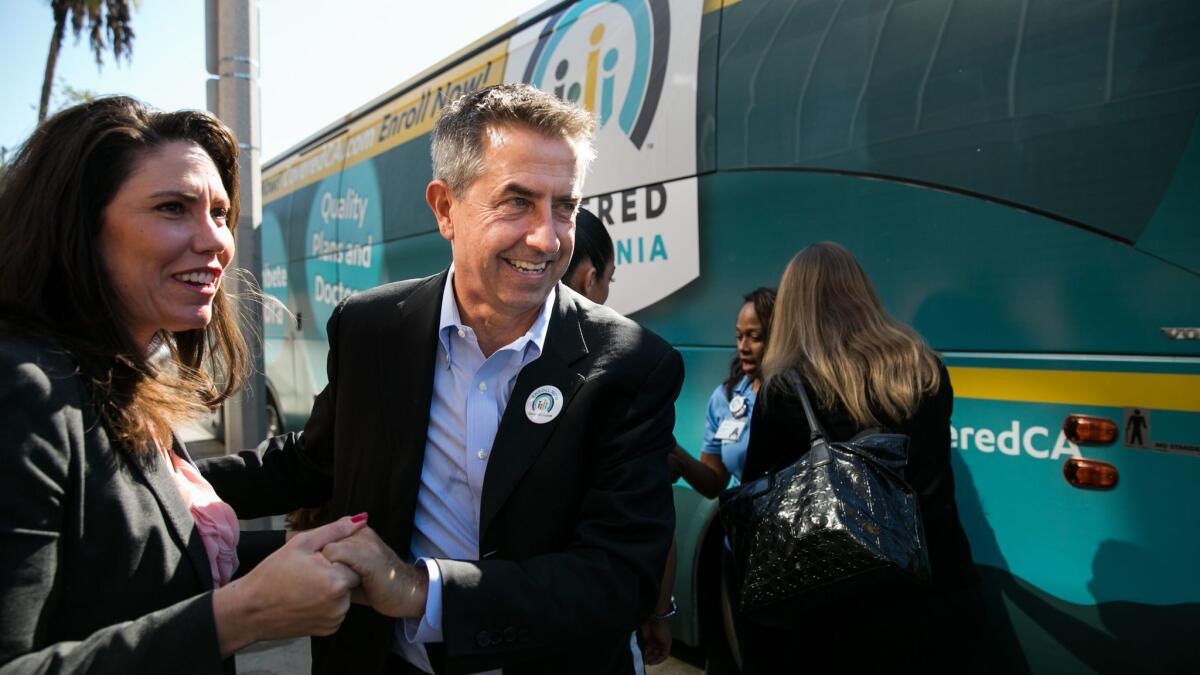Covered California slaps a surcharge on health plans as Trump remains coy on subsidies

California’s health insurance exchange said Wednesday it has ordered insurers to add a surcharge to certain policies next year because the Trump administration has yet to commit to paying a key set of consumer subsidies under the Affordable Care Act.
The decision to impose a 12.4% surcharge on silver-level health plans in 2018 means the total premium increase for those policies will average nearly 25%, according to Covered California.
Taxpayers, not consumers, will bear the brunt of the extra rate hike because federal premium assistance for policyholders, which is pegged to the cost of coverage, will also increase.
Statewide, rate increases will vary by insurer and region. What consumers pay depends on where they live, their income, what level of coverage they want and which insurer they choose.
Californians can get their first look at next year’s health plan prices and options on the state’s rate calculator, released Wednesday.
The state’s open enrollment period, which is longer than that for the federal exchange, runs from Nov. 1 to Jan. 31. About 1.4 million Californians buy their own coverage through the state marketplace and nearly 90% receive financial assistance that reduces what they pay.
In August, Covered California announced that 2018 premiums would rise by 12.5%, on average, statewide. That ticked down slightly to 12.3% during regulatory review. But the exchange also warned that the additional increase, averaging 12.4%, would be added to the silver-tier plans if President Trump failed to commit to continued funding for the so-called cost-sharing subsidies that help reduce some consumers’ out-of-pocket expenses. Those payouts total about $7 billion this year nationwide.
Trump has continued paying the subsidies on a month-to-month basis while repeatedly threatening to cut them off and repeal the entire health law. He has referred to the payments as “bailouts” for insurance companies.
Peter Lee, executive director of Covered California, said the surcharge is far from ideal but that the uncertainty in the nation’s capital left the state with no other option.
“Covered California worked hard to come up with a plan that ensures a stable market and protects as many consumers as possible from an unnecessary price hike,” Lee said in a statement Wednesday.
The exchange took several steps in an attempt to shield consumers from the effects of the surcharge. One of them was to create a new silver plan to be sold outside the exchange to individuals and families who make too much money to qualify for federal subsidies. The surcharge will not be applied to those plans, sparing unsubsidized consumers that extra cost.
Nearly 90% of enrollees receive federal tax credits that help defray their monthly premium bill.
The surcharge will apply only to the silver-level plans, the second-least expensive option among the exchange’s four tiers of coverage. That’s because only people enrolled in silver plans benefit from the cost-sharing subsidies that Trump has threatened to terminate.
Covered California said that 78% of subsidized consumers will see no change in what they pay or may pay even less, despite the surcharge being imposed. The remaining 22% of consumers will see higher net premiums. About half of those consumers will get increases of less than $25 per month, according to the exchange.
In one scenario, the exchange said a 25-year-old in Los Angeles with a $20,000 annual income would see his silver plan rate rise next year from $227 per month to $270. That includes a regular rate increase of $13 plus a silver surcharge of $30.
But that person would pay only $13 more per month out of his own pocket, because the federal premium subsidy would increase from $160 to $190, fully offsetting the surcharge. Statewide, the surcharges on silver plans vary among health insurers from 8% to 27%.
John Baackes, chief executive of L.A. Care Health Plan, said his 2018 rates will rise almost twice as much as anticipated because of the added surcharge — a 23% average increase instead of 12%. His health plan has about 26,000 exchange enrollees.
Baackes said the higher premiums would be “totally avoidable” if the Trump administration implemented the ACA, also known as Obamacare.
“We have to lay the blame for this at the foot of the Trump administration for being so irresponsible about this major portion of the law,” he said. “This will not be a burden on most consumers, but it will be a higher cost to the U.S. Treasury. It all seems so ridiculous.”
The last-minute changes, less than three weeks before the start of open enrollment, are likely to confuse some consumers.
In addition to higher rates, Covered California faces the loss of a major insurer across much of the state. In August, Anthem Blue Cross said it was pulling out of about half of California’s counties, forcing 153,000 customers to find new coverage.
The state has boosted its marketing budget by $5.3 million for the coming year to help Anthem customers research their options and to deal with questions stemming from the surcharge.
California’s Obamacare rates have been a key barometer of how the Affordable Care Act is working since coverage began in 2014. The state held rate increases to 4% the first two years and then premiums jumped 13.2%, on average, for 2017.
Some members of the U.S. Senate have attempted to craft a bipartisan deal to fund the cost-sharing subsidies for up to two years in a bid to stabilize the exchange markets nationwide. But those negotiations stalled last month when Senate Republicans pursued the Graham-Cassidy healthcare bill, the latest GOP attempt to roll back President Obama’s signature law. Like previous repeal attempts, it failed to muster enough support in the Senate.
State officials and health insurers across the U.S. have faced tough decisions on whether to proceed with higher rates to compensate for the uncertainty swirling around the ACA. Deadlines were pushed back repeatedly as state insurance commissioners and exchange directors pleaded with Trump and Congress to shore up the existing market so insurers would stick around and rate increases could be minimized.
In Idaho, the average rate for silver plans will increase 40% in 2018, double what the hike would have been had the Trump administration committed to funding the cost-sharing subsidies, according to Dean Cameron, director of the state’s Department of Insurance.
If the cost-sharing subsidies are continued into next year, the added surcharges could mean insurers will end up collecting too much in premiums, and some arrangements will have to be made to return the excess money.
Trump has continued to rail against Obamacare, pointing to huge rate increases around the country and insurance companies fleeing the market. Rather than amending the Affordable Care Act, Trump favors other proposals to help make health insurance more affordable for individuals and families.
This week, he is expected to issue an executive order that would allow people and small businesses to join together and buy health insurance through what are known as association health plans.
Details haven’t been released yet, but some health policy experts say these new plans could further destabilize the ACA’s insurance markets if they aren’t subject to the health law’s regulations.
Terhune is a senior correspondent for Kaiser Health News, an editorially independent publication of the Kaiser Family Foundation. Kaiser Health News reporter Rachel Bluth in Washington, D.C., contributed to this report.
UPDATES:
4:10 p.m.: This article has been updated to include an example of how surcharges and subsidy changes would affect a consumer.
The article was originally published at 1:15 p.m.
More to Read
Inside the business of entertainment
The Wide Shot brings you news, analysis and insights on everything from streaming wars to production — and what it all means for the future.
You may occasionally receive promotional content from the Los Angeles Times.











